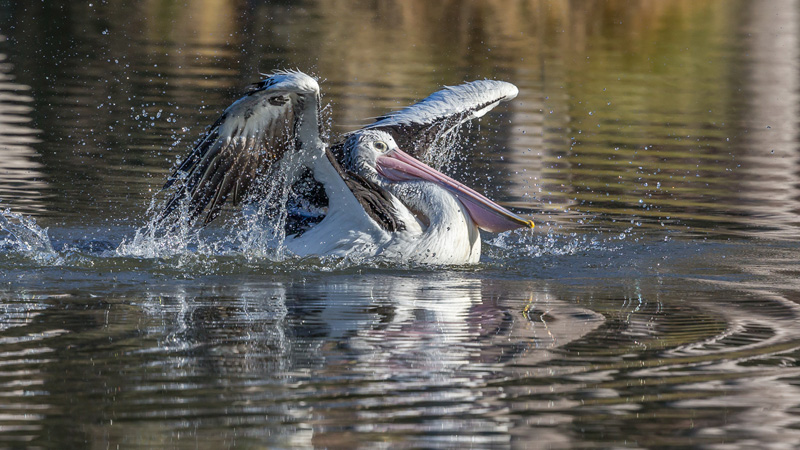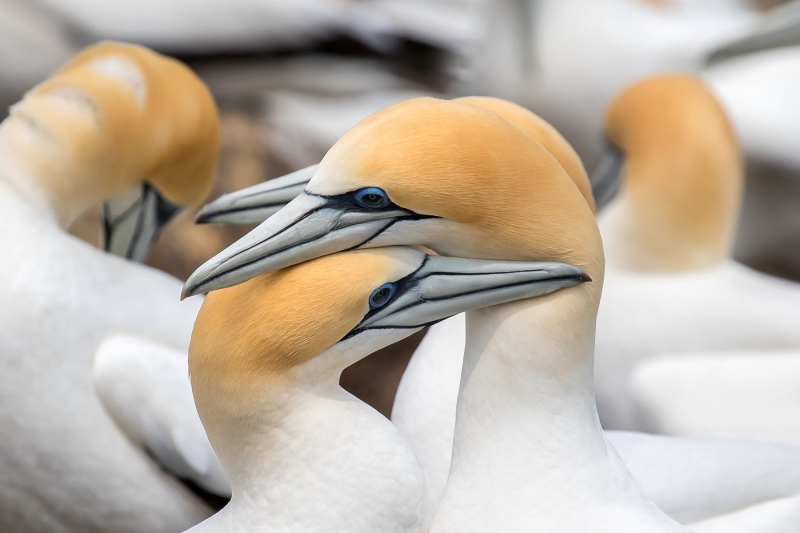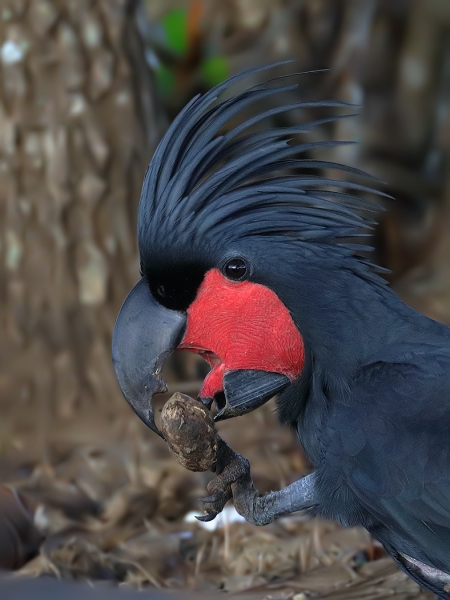This is a bumper crop of good quality images and I found making the final choices difficult.
At the Intermediate level photographers should be starting to work beyond studies of a bird standing still or a bird perched on a stick. Possible initiatives include capturing images of birds engaging in some activity, capturing multiple birds in the same frame, using perches as pictorial props (mosses, lichens, arrangements of leaves and flowers), sensitive management of light and colour, using the natural and human-built environment as important elements in the composition, and/or using innovative camera/lens techniques. To this end I have given some preference to images where photographers have tried for something fresh and challenging in capture, processing or presentation.
To sort out the 95 images I began by dividing them into three categories: ‘Yes’, ‘Maybe’ and ‘No’. As I went through I made notes about the reasons why each image was allocated to a category. This left me with well over 70 images in the ‘Yes’ and ‘Maybe’ categories.
I then applied the standard technical tests such as exposure and sharpness. The judging was getting quite hard by this stage because the better images were very even when it came to technical standards. While doing this, I also checked the comments sections. I kept those images in the bag that had comments that added to the viewing experience.
I then applied some final tests: Did the image tell a story? Did the image have a Wow! factor? What was the comparative degree of difficulty? For example, did the photographer reach for something more difficult and complex than a straight portrait of a perched bird? Was the composition effective? Finally, did I want to get back to the image for some more viewing enjoyment?
Images were marked down for the following reasons:
- Too dark. For some otherwise excellent images, this was my greatest regret in reviewing the images. It would take very little time moving the light/darkness sliders back and forth to get superior outcomes. Or perhaps screen calibration would be in order.
- Bird plonked in the centre of the image.
- No light/colour in the eye.
- Over-sharpening: feathers look wiry, light line artefact around the outside contours of the bird.
- Saturation/hue cranked up to generate fake colours.
- Sticks mismanaged. In a composition which basically includes a bird and some sticks, the sticks can dominate because the eye is drawn to the linear features and tends to follow the sticks around. This can muck up the response to the bird itself.
- Shadow management. There are shadows and shadows. Dark black shadows on a white bird, large areas of black, and dark shadow lines across a bird should all be avoided unless there is an intent to make use of the shadows.
- A bit of obstruction might not matter. It might even be manipulated successfully to be a constructive part of the composition. But a lot of obstruction does matter, again unless it is the intent of the photographer in order to improve the composition.
- Depth of field not enough to capture all or most of the bird.
- Softness, particularly when it is around the head.
- Whites blown, blacks an impenetrable black, or the reds fused.
- Distracting clutters of vegetation, soil, stones, etc.
- Cloning that had left a visible trail.
Many of these shortcomings can readily be turned around and used as a checklist for improve image capture and processing.
Winner: Australasian Gannet, by John Eley (Image ID 33928)
What is truly remarkable about this image is that it succeeds in conveying a delicate sense of touch. It does this by the way in which the bill of one bird causes an indentation in the neck feathers of the other bird. Those beaks are powerful enough to absorb enormous impact during the dives as well as to kill fish.
Overall this image shows a wonderful gradation between extra sharp and crisp detail through to softness. This is particularly appropriate for the content which is an intimate portrait of pair bonding behaviour. Taking images of birds in a flock is a challenge because of obstruction and the difficulties of dealing with a clutter of bird parts in the depth of field and beyond. In this case the third beak is a distraction. On the other hand, the general pattern of whites and golden yellows works well.
Commended: Australasian Gannet, by Con Duvestyn (Image ID 33894)
This is wonderful flight shot with good levels of crisp detail. The bird is positioned well in the image so we get the distinct sense that the next move is a plunge downwards and to our right as we view the image. Minor issues include some small blowout in the white areas. The comments are a useful addition to our appreciation of the image.
Commended: Whistling Kite, by Adam S Kraska (Image ID 33951)
Wow! This is a high risk entry. It has issues with lack of focus and of softness in some areas and with the shadows of the far wing tip. On the other hand, the closeness to the action, the cropping, the sweeping lines, and the positive and negative spaces of this composition brings us face to face with the sheer power of a raptor. The half-closed nictitating membrane is one of those small details that can add so much to the overall image. Some of the soft areas would respond to use of the unsharp mask tool. So, despite the technical shortcomings this is an image that has great power. The photographer’s explanation of why he chose to present the image as he has is a useful addition to our understanding of the image.
Commended: Australian Pelican, by Linda Unwin (Image ID 34312)
Bathing images are a challenging sub-genre of bird photography. The key is that the water will have equal or greater pictorial space than the bird. The water cannot simply be bokeh. It has to contribute substantially to the composition. At the same time, if the bird is completely bedraggled, the image may lose sense and impact. Another challenge is that water itself can lack form, creating a messy melange. This image addresses the various challenges well. In this case the important visual points of the Pelican – the eye and the beak – are crisp. The mini-waterfalls running from the leading edges of the wings are sharp. These lines conform well with the lines of the main wing feathers. Despite lots of action there is sufficient calm water around the bird to provide pleasing shapes in the waves. The small reflections of colour highlights in the water are pleasing. The composition is enhanced by the placement of the bird in the frame. The small area of shadow under the beak does not unduly distract from this image. The photographer’s comments evince engagement with the bird and help inform the viewer’s response.

[Note: this image is no longer available in our galleries.]
Commended: Palm Cockatoo, by Con Duvestyn (Image ID 33978)
This is a wonderful composition at both the macro and micro levels. The side-on portrait of this bird generates powerful lines from the repeated curves of the crest which draw the eye to the point of interest. The angles of the upper and lower mandibles complement this and all these lines are anchored by the angle of the leg which is holding the nut. At the micro level the red shape of the face moving into the red tongue effortlessly guides the eye to where the action is. The image is sharp where it needs to be. The bokeh works except where a small area of white in the bokeh gives undue emphasis to the lower claw. Overall, the image is rather dark and it would be worth selecting the darker areas and doing some local readjustment.
Commended: Red-headed Honeyeater, by Chris Young (Image ID 33853)
Flight shots of small birds in flight are a major challenge. The composition is a simple triangle with the high point of the triangle occupied by the head and beak. This dominant position in the shape is emphasized by the dominance of a significant patch of red in the composition. The result is that the viewer looks where the photographer wants the viewer to look: at the head. The upwards angle of flight is complemented by blur of the wings. The bokeh does not distract here. The photographer’s comments are a useful addition to our appreciation of the image.
Commended: Grey Butcherbird, by Catherine Noone (Image ID 34097)
This image has one quality that makes it stand out from the pack: it has an artist’s eye for composition. All the elements in the picture count, not just the bird. The key is to see the flat masses. The general tones of light, colour and shapes of this composition work well together. This is a refreshing bird image! The picture tells an important story: increasingly birds must live and survive in human environments. The photographer’s comment shows someone ready for all opportunities and open to new ways of seeing and representing birds. The image would benefit from cropping a slice off the right hand side of the image in order to have the bird ‘looking into’ the main space. The other aim for the cropping would be to balance the mass of the pole with the mass of the bird in the composition.
Honourable Mention: Dusky Honeyeater, by Gary King (Image ID 33560)
Dusky Honeyeaters are such quick movers that there are few high quality images of them in the galleries. Images of bathing birds are tricky. The water droplets here convey action. They have also absorbed the tones of the general colour scheme. The key parts of the bird are sharp, noting that parts of the bird are out of the depth of field and possibly suffering from blur motion. The round orange fruit in the background is a small distraction. All-in-all a good outcome for an image with a high degree of difficulty.
Honourable Mention: Red-eared Firetail, by Jane Putland (Image ID 34259)
This image has three positive elements. Its perch adds significantly to the composition. The bokeh does not distract. And then we have that special little detail that lifts the image – the kangaroo fur. Some softness of the bird itself might be lifted by use of the unsharp mask tool. The photographer’s comment shows that the image was planned and executed deliberately for a good outcome.














